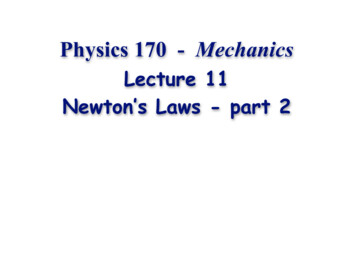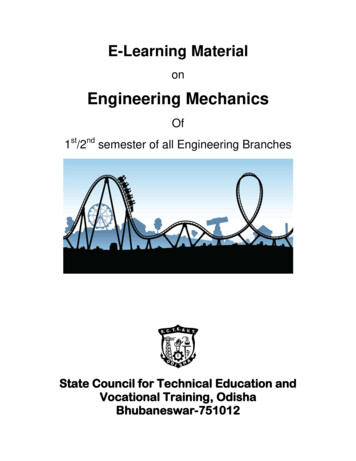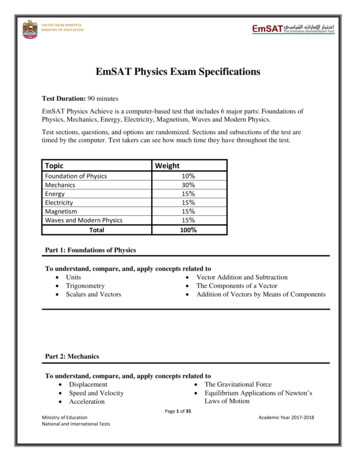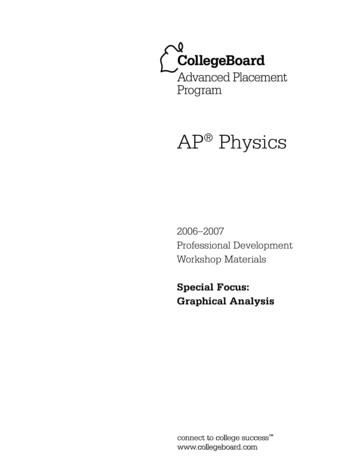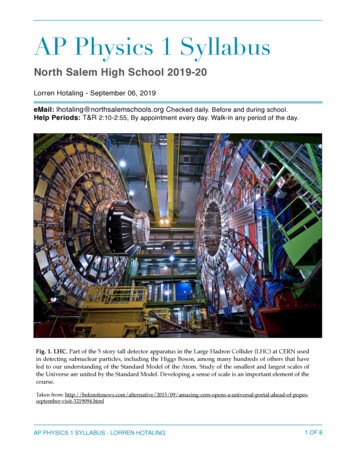
Transcription
Physics 170 - MechanicsLecture 28Rotational Dynamics
Example: Spinning the WheelYou are sitting on a stool on a frictionless turntableholding a bicycle wheel. Initially, neither the wheel northe turntable is spinning. You hold the axel verticalwith one hand and spin the wheel counterclockwise withthe other hand.You observe that the stool and turntable begin torotate clockwise. Then you stop the wheel with yourfree hand.What happens to the turntable rotation?The turntable stops!
Example: Tipping the WheelA student sitting on a stool on a frictionless turntableis holding a rapidly spinning bicycle wheel. Initially, theaxis of the wheel is horizontal, with the angular momentumvector L pointing to the right.What happens when the student tips the wheel so thatthe spin axis is vertical, with the wheel spinningcounterclockwise?The system is free to rotate about the vertical axis (novertical torques) and initially the angular momentum is zeroalong that axis. Therefore, vertical angular momentum isconserved and the final angular momentum must also be zero.In the final state, the wheel has a large angularmomentum pointing vertically upward, so the stool andstudent must rotate clockwise to have an equal and oppositedownward angular momentum.
QuestionI am initially at rest on the rotatable chair, holdingthe wheel spinning as shown in [1]. Now [2] I turnit over and the chair starts to rotate.Question: What happens if [3] the wheel is turnedover in the same direction one more time?[1][2]?[3](a) rotation stops; (b) rotation doubles; (c) rotation stays the same
Turning the Bike Wheel TwiceLNETLW[1]LNETLW[2]LSLNETLW[3]notturning
Example:Ride the Merry-Go-RoundA 25 kg child at a playground runs with an initialspeed of 2.5 m/s along a path tangent to the rim ofa merry-go-round with a radius of 2.0 m and jumpson. The merry-go-round, which is initially at rest,has a moment of inertia of 500 kg m2.Find the angular velocity of the child and merrygo-round.
Example: merry-go-roundA nearby park has a merry-go-round with a 3.0 mdiameter turntable that has a 130 kg m2 moment ofinertia. Initially five friends stand near the rim whilethe turntable rotates at 20 rev/min. Four friends moveto within 0.3 m of the center, leaving Gene atthe rim. Gene is quick and strong, so it would require anacceleration of 4.0 g to throw him off. Assumeeverybody has a mass of 60 kg will Gene stay on themerry go round?No!
Rotational CollisionsIf the moment of inertia increases, the angularspeed decreases, so the angular momentum doesnot change.Angular momentum is conserved in rotationalcollisions:
Example: Two Interacting DisksA 20 cm diameter 2.0 kg solid disk is rotatingat 200 rpm. A 20 cm diameter 1.0 kg circularloop is dropped straight down on the rotatingdisk. Friction causes the loop to accelerate untilit is “riding” on the disk.What is the final angular velocity of thecombined system?
Example: A Rotating DiskDisk 1 is rotating freely and has angularvelocity ωi and moment of inertia I1about its symmetry axis, as shown.It drops onto disk 2 of moment ofinertia I2, initially at rest. Becauseof kinetic friction, the two diskseventually attain a common angularvelocity ωf.(a) What is ωf?(b) What is the ratio of final to initial kinetic energy?
Rotational Work & PowerA force F acting through a lineardisplacement Δx does work: W FΔx.Similarly, a torque τ acting through anangular displacement Δθ does work:The work-energy theorem applies as usual.
Rotational Work & PowerPower is the rate at which work is done, forrotational motion as well as for translationalmotion.Again, note the analogy to the linear form:
The Vector Nature of Rotational MotionConservation of angular momentum meansthat the total angular momentum around any axismust be constant. This is why gyroscopes are sostable.
Gyroscopic Motion Suppose you have a spinning gyroscopein the configuration shown below: If the left support is removed,what will happen?Support(to be removed)ωg The gyroscope does not fall down!pivot
Gyroscopic Motion The gyroscope precesses around itspivot axis ! This rather odd phenomenoncan be understood by usingthe vector character of :ωpivot
Gyroscopic Motion The magnitude of the torque about the pivot isτ mgd. The direction of this torque at the instant shown isout of the page (using the right hand rule).– The change in angular momentum at the instantshown must also be out of the page!dLωmg
Gyroscopic Motion Consider a view looking down on the gyroscope.– The magnitude of the change in angularmomentum in a time Δt is ΔL LΔφ.– Sowhere Ω Δφ/Δt is the “precession frequency”L(t)ΔL τ Δ tΔφ(L(t Δt)top viewpivot
Gyroscopic MotiondΩ SoLωpivotmg In this example, τ mgd and L Iω: The direction of precession is given by applyingthe right hand rule to find the direction of τ andhence of ΔL/Δt.
Physics 170 - Mechanics Lecture 28 Rotational Dynamics. Example : Spinning the Wheel You are sitting on a stool on a frictionless turntable holding a bicycle wheel. Initially, neither the wheel nor the turntable is spinning. You hold the axel vertical



